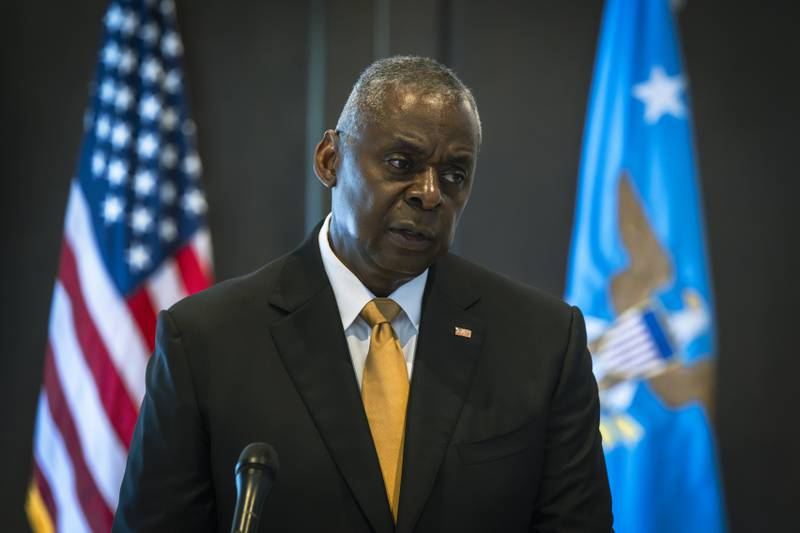BRUSSELS — NATO’s top official said he “welcomed” the choice by many countries in the alliance to let Ukraine fire across the border into Russia, arguing that the former restrictions in place ignored Ukraine’s right to protect itself.
“The right of self-defense includes also striking legitimate military targets on the territory of the aggressor: Russia,” said Jens Stoltenberg, the secretary general of NATO.
Stoltenberg spoke to a crowd of reporters near the entrance of the alliance’s headquarters in Brussels. Behind him, American and European officials entered ahead of a meeting of countries that gather each month to coordinate support for Kyiv.
In opening remarks shortly after, U.S. Secretary of Defense Lloyd Austin updated the list of numbers showing Russia’s costs incurred during the war: 350,000 casualties, 24 ships sunk or damaged, 2,600 armored vehicles destroyed.
This is the first such meeting since the U.S., following others in the alliance, loosened the rules on some of the weapons it’s sending Ukraine. To this point in the war, America hasn’t allowed Ukrainian forces to fire any munitions it’s provided into Russia, fearing escalation with a nuclear-armed adversary.
RELATED

That policy changed in late May, when the administration made a carve-out for targets around Kharkiv, Ukraine’s second-largest city. Russia opened a new offensive around the city earlier that month, which forced Western countries to rethink their restrictions.
“The border and the front line is more or less the same” near Kharkiv, which sits close to Russia, Stoltenberg said. “If the Russian forces — the artillery, the missile batteries — were safe as soon as they were on the Russian side of the border, it would become extremely difficult for Ukrainians to defend themselves.”
Ukraine has since taken advantage of the policy change to hit Russian forces across the border — one of the reasons U.S. officials have said the front lines near Kharkiv have steadied.
Earlier this week, Ukraine’s General Staff reported hitting Russian air defense batteries in Crimea, a Ukrainian peninsula Russian forces seized in 2014. The range of the strikes would likely have required western weapons, such as the longer-range Army Tactical Missile System, or ATACMS, which can fire up to around 200 miles.
The U.S. still doesn’t allow Ukraine to fire these longer-range weapons into Russia. Ukrainian officials, including President Volodomyr Zelenskyy, have chafed at that restriction, saying they’re at once grateful for the policy shift but think it’s insufficient.
One of the reasons is a target still outside Ukraine’s reach. Russian bombers parked on airfields farther back have been pounding Ukrainian cities for the last year.
American officials have two concerns about lifting the remaining restrictions.
One is to make sure Ukraine makes the best use of the weapons provided, which involves concentrating the fires as much as possible. And another is the concern over escalation. Russia has the world’s largest nuclear arsenal and has threatened their use multiple times during the war.
Stoltenberg, who publicly supported lifting the earlier restrictions before the U.S. did so, argued that the burden shouldn’t be on Ukraine or its allies to avoid escalation, given that Russia started this war to begin with.
“Ukraine has the right to strike military targets on Russian territory, part of the right to self defense, and we have the right to support them in defending themselves,” he said.
The question will grow more pressing later in the summer when Ukraine receives F-16 fighter jets, an effort the Netherlands and Denmark are leading as Ukrainian pilots complete training in the U.S.
On the flight to Brussels, Gen. CQ Brown, America’s top military officer, said in a short interview that those planes would lengthen Ukraine’s range of fire and support the country’s defense. He declined, though, to say whether they should be able to fire across the border, deferring the question to policymakers.
U.S. officials often urge the public not to focus on any one weapon or rule as a breakthrough during the war, and Brown too mentioned the broader set of equipment being provided as more important.
“It all comes together to give them just added capability to defend themselves,” he said.
Noah Robertson is the Pentagon reporter at Defense News. He previously covered national security for the Christian Science Monitor. He holds a bachelor’s degree in English and government from the College of William & Mary in his hometown of Williamsburg, Virginia.
- SEO Powered Content & PR Distribution. Get Amplified Today.
- PlatoData.Network Vertical Generative Ai. Empower Yourself. Access Here.
- PlatoAiStream. Web3 Intelligence. Knowledge Amplified. Access Here.
- PlatoESG. Carbon, CleanTech, Energy, Environment, Solar, Waste Management. Access Here.
- PlatoHealth. Biotech and Clinical Trials Intelligence. Access Here.
- Source: https://www.defensenews.com/global/europe/2024/06/13/nato-chief-continues-push-to-let-ukraine-hit-russian-based-targets/



